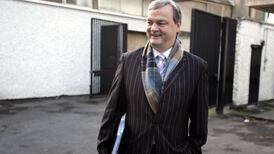In Conway Street in west Belfast, the shadow of August 1969 remains on the walls. On the gable end of a former linen mill the outline of a house survives, its pitched roof and chimney burned into the brickwork.
Fifty years ago, Conway Street was burning. Homes in the predominantly Catholic street were attacked by a loyalist mob throwing petrol bombs; the RUC responded by baton-charging the Catholic crowd, then sending in armoured cars with heavy machine guns mounted on top. The chaos was repeated in other parts of west and north Belfast, and seven people died.
It was the beginning of a mass movement of population which would see previously “mixed” streets redesignated as Catholic or Protestant. Residents were either forced out of their homes or chose to flee, some to refugee camps across the Border.
Visitors come every year to see the murals of Bobby Sands, Nelson Mandela and others, or to visit the Troubles' memorials on the rebuilt Bombay Street
The 1972 Scarman report, carried out by a British judge, later estimated that 179 homes were destroyed in the violence of August 1969, including Bombay Street, which was completely burned down. About 1,800 families left their homes; 1,500 of these were Catholic and 300 Protestant. In total, up to 15,000 people would be displaced in Belfast in the first 10 years of the Troubles.
Temporary barricades which were thrown up amid the violence hardened into permanent lines of demarcation: the so-called peace walls which still divide Belfast’s streets to this day.
One of the best-known runs past Conway Street along Cupar Way, separating the Catholic Falls from the Protestant Shankill. Corrugated metal sheeting, its green paint reminiscent of Troubles-era security installations, reaches high into the air. It is topped by an even higher wire mesh, to block missiles.
Tourist attraction
Further along, this wall is a tourist attraction. More and more visitors come every year to see the murals of Bobby Sands, Nelson Mandela and others on the “international” section of the wall along the Falls, or to visit the Troubles’ memorials on the rebuilt Bombay Street.
Here, black-taxi tours deliver carloads of tourists with clockwork regularity. “I’d love to talk to you, but I’ve another tour in an hour,” more than one guide explains to The Irish Times.
A group of Americans stand on a bench, to get a better view of the wire mesh which protects the back of the houses overlooking the peace wall. A metal frame extends from the bottom of their roofs across to the back fence and down to the ground; it resembles nothing so much as a cage.
“Doesn’t bother me,” one resident says. “We’re used to it. I’d rather have the wall there. It keeps us safe.”
'The peace wall is better staying up. I don't want it taken down. We had a questionnaire asking us how we'd feel if the peace wall came down...it'd just be murder on the street'
This is an oft-repeated sentiment on both sides of peace walls. In Madrid Street, in east Belfast, the divide is easy to miss. A mural celebrating the history of women in the area overlooks a small garden, with high hedges behind. Here is, in fact, a peace wall, separating the Catholic enclave of the Short Strand from the Protestant areas off the Newtownards Road.
Roseanne Thompson lives a few houses away. She says she has been injured in rioting, and a friend had her arm broken. Her house has been attacked with paint bombs and other missiles, and her children’s toys destroyed in the back garden.
“The peace wall is better staying up. I don’t want it taken down,” she says. “We had a questionnaire coming round asking us how we’d feel if the peace wall came down. I’d be away because it’d just be murder on the street.”
On the other side of the wall lives Brian McMullan. He points out damage to his front door where it was hit by a missile thrown over the wall. “My view, that wall stands as long as I’m alive,” he says. “I have peace and quiet when that wall is there.”
In the past, the Short Strand interface has been a flashpoint. The Madrid Street wall was erected relatively recently, in 2003-2004. The local church, St Matthew’s, has a mobile peace fence, dating from 2013, which can be raised and lowered as the situation demands.
Strategy plan
That same year, the Northern Ireland Executive’s Together: Building a United Community strategy plan aimed to remove all peace walls – or “interface barriers” – by 2023. This now appears optimistic, not least in the continued absence of a devolved government in Northern Ireland, and the communities that live near peace walls remain among the most deprived in the North.
Of the approximately 80 peace walls in Northern Ireland, the vast majority are in Belfast. About 15 of them are in Housing Executive hands, though some of these – such as Madrid Street – have been “re-imaged” as part of a strategy to change perceptions around peace walls.
Consent is key. A Housing Executive spokesman explained that any work “is undertaken at the pace of each individual community and only in circumstances where residents feel safe and confident in removing these symbols of segregation”.
On the Crumlin Road in Ardoyne in north Belfast, the change is evident. Three years of negotiations between residents in Catholic Ardoyne and Protestant Woodvale, “until residents felt comfortable taking down this physical and mental barrier”, led to the Housing Executive’s first removal of a peace wall in 2016.
“We believe through these community-led projects we can create peace by building respect and trust instead of walls made of bricks and mortar,” a spokesman said.
Today, the Crumlin Road is as unremarkable as any main road. There are houses on one side, a nursing home on the other, and plenty of traffic whizzing past. Nobody would guess that there was once a peace wall here.















